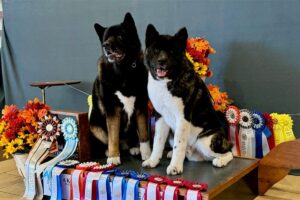
The Performance Akita
Explore Performance Akitas excelling in Rally, Obedience, Agility, Scentwork, and more! Redefining breed excellence beyond the show ring.

Home » Dog Breeds » Akita Dog Breed
The Akita is a powerful, dignified breed originating from Akita Prefecture on the Japanese island of Honshu. The breed is renowned for its large, powerful appearance and its noble and intimidating presence. The Akita is revered for its loyalty and courage, often serving as both a symbol of good health and as a guardian. These dogs carry themselves with an almost “bear-like” strength and a remarkable composure that reflects their dignified heritage. In many countries, the breed is known as the American Akita.
Working
24 – 28 Inches
70 – 130 Pounds
10 – 14 Years
| Country of Origin | Japan |
|---|---|
| Bred For | Bear Hunting, Guarding, Companionship |
| Known For | Affection, Powerful Appearance, Protectiveness |
| Popularity | Medium |
| Temperament | Alert, Dignified, Courageous |
| Activities | Hunting, Running, Hiking, Conformation Shows, Dog Sports |
The Akita is a breed with a storied past, originating from the mountainous regions of Northern Japan. Esteemed for centuries for their loyalty and courage, these dogs were bred for hunting big game such as elk, wild boar, and bear. The breed’s unwavering loyalty was epitomized by the famous Hachikō, an Akita who, following his owner’s death, faithfully awaited his master’s return each day at train station for nearly ten years.
The Akita’s lineage faced a serious threat during World War II, with government orders issued to cull all non-combat dogs. Some Akitas were released into the wild or crossbred with German Shepherd Dogs to avoid this fate. Morie Sawataishi and other dedicated supporters of the breed played a pivotal role in preserving the purebred Akita during these trying times.
The breed was officially recognized by the Fédération Cynologique Internationale (FCI) on a definitive basis on March 13, 1964. An official Breed Standard was published on March 13, 2001. The Akita was also recognized by the American Kennel Club (AKC) in 1972, marking a significant milestone in the breed’s history outside its native Japan. This recognition not only helped to preserve the unique qualities of the Akita, it also paved the way for its appreciation on a global scale.
From the mountainous terrain of Northern Japan, the Akita has emerged as a symbol of strength, loyalty, and companionship. Although they once roamed the snowy landscapes hunting formidable game, their role has evolved tremendously. Today, Akitas have transcended their traditional duties, becoming cherished protectors of hearth and home. Their historical significance and unique character continue to endear them to dog enthusiasts globally, securing the breed’s place in the hearts of those they loyally serve and protect.
Adult male Akitas boast a robust frame and typically stand between 26 and 28 inches tall at the shoulder, whereas mature females are slightly smaller, ranging from 24 to 26 inches in height.
The weight of a male Akita in healthy condition usually varies from 100 to 130 pounds, while the female’s weight should be proportionately less, roughly between 70 and 100 pounds.
The Akita exhibits a majestic presence with a well-proportioned, solid frame that exudes strength without the impression of bulkiness. The breed is longer than it is tall, adhering to a length-to-height ratio of 10 to 9 for males and 11 to 9 in females.
The breed’s substance is robust, characterized by a well-muscled physique and heavy bone, providing these dogs with the necessary power and endurance required for their historic roles. Despite their sturdy build, Akitas move with an agile grace that belies their size. The harmonious blend of strength and substance creates an impressive silhouette, one that is distinctly spitz-like with an unquestionably refined dignity.
Texture: The Akita’s coat is a hallmark of the breed, boasting a double layer that provides insulation against harsh environmental conditions. It is an essential aspect of the breed. The breed’s straight, harsh outercoat offers protection in all weather conditions, and the dense, soft undercoat provides insulation. The coat’s length measures approximately two inches on the withers and rump, slightly longer on the body. On the head, ears, and legs the hair is short, but on the tail it is rather long. Unlike some other spitz-type breeds, there is no ruff around the neck or feathering on the legs.
| Standard Color | |
|---|---|
| Black | ee |
| Fawn | ee |
| Red | ee |
| White | ee |
| Brown Brindle | ee |
| Red, Black Overlay | ee |
| Silver, Black Overlay | ee |
| Brown, Black Overlay | ee |
| Fawn, Black Overlay | ee |
| Red Brindle | ee |
| Silver Brindle | ee |
| Black, Red Undercoat | ee |
| Black, Fawn Undercoat | ee |
| Black Brindle | ee |
| Fawn Brindle | ee |
| Black, Brown Undercoat | ee |
| Black, Silver Undercoat | ee |
| White, Red Shading | ee |
| Brown | ee |
| Silver | ee |
| Standard Marking | |
|---|---|
| Black Mask, White Markings | ee |
| Black & White Mask White Markings | ee |
| Pinto, Black & White Mask | ee |
| Black Mask | ee |
| White Mask | ee |
| Pinto, Black Mask | ee |
| White Mask, White Markings | ee |
| Pinto | ee |
| White Markings | ee |
A Note About Color: The Akita may be pinto or brindle in color, with or without white markings and/or a black mask. Pinto-marked dogs are white with large, evenly placed patches on the head and more than one-third of the body. Solid white is an acceptable color for the breed; however, the merle pattern and liver colored-coats are not.
The tail of an Akita is large and full, set high and carried over the back in a gentle or double curl that touches the back or drapes over the flank on either side. It is a distinguishing characteristic of the breed, adding to the overall impression of strength and nobility.
Akitas have tails that contribute greatly to the breed’s characteristic silhouette. The tail is large and strong, and is covered in straight and coarse hairs without creating a plume. It curves gracefully over the back or to the side in a full, double, or three-quarter curl. The tail is never docked, and uncurled or sickle-shaped tails are unacceptable in the breed.
Bringing an Akita into the home means inviting in a dog with a proud heritage and a dignified temperament. Known for its unwavering loyalty and noble disposition, this breed can be a joy to own for experienced dog handlers. However, it is crucial to consider its specific needs and characteristics to ensure a harmonious relationship with everyone in the home.
The Akita is generally hearty and robust, but the breed is not without a few breed-specific health challenges. Owners should be proactive in understanding these potential issues and engage in preventive healthcare practices. Collaborating with a reputable breeder and a veterinarian who is familiar with the breed can be instrumental in maintaining the health and happiness of an Akita.
Lifespan: The life expectancy of an Akita is typically around 10 to 14 years. With attentive care, including regular veterinary check-ups and a well-managed diet, dogs of this breed can enjoy a long and vibrant life.
The Akita, like all breeds and mixed breeds, has certain health risks for which some individuals may be predisposed. It is essential for prospective caretakers to be aware of these risks in order to provide the best care possible.
Owners of Akitas are encouraged to have a close relationship with their dog’s breeder and to be particularly vigilant of any signs that indicate the onset of these issues. Regular veterinary check-ups and appropriate health screenings can help to manage the risks and provide early diagnosis of any serious condition.
The Akita is known for having a dignified and reserved personality, often showing a profound loyalty to family members. This makes the breed an excellent companion in the right home. However, these dogs can be aloof with strangers and they can exhibit a strong guarding instinct, a trait that requires careful socialization from a young age. Despite their strong-willed nature, Akitas may be a good match for those novice owners who are committed to understanding and catering to the breed’s specific needs.
Akitas prefer not to be left alone for extended periods, thriving on companionship and interaction with their human partners. They generally coexist well with other dogs if they have been properly socialized, but it is worth noting that they may show dominance, which calls for careful management. Similarly, the breed’s sensitivity level is quite high. Akitas are responsive to their environment and can be affected by changes in their routine or household.
The Akita’s attitude towards strangers varies from dog to dog. Some may be welcoming, while others will be more reserved. Early and continuous socialization is key to fostering a well-adjusted temperament. When it comes to children, Akitas can be good-natured and protective. However, interactions should always be supervised, especially with young children, to provide a safe environment for both the kids and the dog.
Feeding an Akita requires attention to their nutritional needs at different stages of life. Puppies, with their rapid growth, may need a diet formulated for large breeds to make sure that their bones and joints develop properly. Adult Akitas, known for their sturdy physique, will thrive on a well-balanced diet that maintains their muscular build without leading to excess weight, which can exacerbate potential health issues like hip dysplasia.
The amount of food an Akita will require can vary based on their size, age, metabolism, and activity level. Typically, an adult Akita may need between 3 to 5 cups of high-quality dry dog food per day, divided into two meals. This is a general guideline, and it is important to monitor your dog’s weight and adjust food portions accordingly to avoid overfeeding.
As for puppies, they will need more frequent feedings of specially formulated food to accommodate their developmental needs. This could mean 3 to 4 meals a day for very young puppies, gradually reducing to two meals as they mature. Always make sure that fresh water is available, and discuss your dog’s diet with your veterinarian to tailor it to your dog’s specific health requirements.
Training an Akita requires patience, consistency, and an understanding of the breed’s independent nature. These intelligent dogs respond well to training that includes positive reinforcement and mutual respect. Despite their independent streak, Akitas have a good capacity to learn and can be trained effectively, especially when the training is started early in their puppyhood.
Akitas are not known for being overly vocal, but they will bark to alert their handlers to anything unusual, making them excellent watchdogs. It is important to teach them when barking is appropriate to prevent excessive noise.
Their intelligence is one of their most notable attributes, which means they can learn quickly, but it also means they can get bored with repetitive tasks. Keeping training sessions short, engaging, and varied will help maintain their focus.
Wanderlust is not typically a trait associated with Akitas, but they do require secure fencing and supervision when outdoors due to their strong prey drive. This breed may exhibit predatory behavior towards small animals, so training should also focus on impulse control to manage these instincts.
Akitas possess a vibrant energy that requires regular exercise to maintain their physical and mental well-being. Although they are not the most hyperactive of breeds, they do have a significant need for daily physical activity. This can be met through walks, play sessions, and opportunities for safe off-leash exercise in a securely fenced area.
| Energy Level | Moderate to High |
|---|---|
| Exercise Requirements | 2 Hours/Day (Minimum), Daily Walks, Vigorous Running, Regular Exercise, Playing with Another Dog, Mental Stimulation |
The intensity of the exercise should be matched to the individual dog’s health, age, and fitness level. Puppies and young Akitas, for instance, will often have bursts of energy and may require more active play, while adults may prefer longer walks or hikes. Akitas also enjoy mental challenges, so incorporating training exercises into playtime can be very beneficial.
As for playfulness, Akitas can be quite playful with their family members, showing a lighter side of their personality at playtime. They tend to be more reserved with strangers, but once a bond is formed, they engage enthusiastically in games and interactive toys.
It’s important to note that Akitas can be prone to overheating in hot weather, so exercise should be done during the cooler parts of the day during summer months, and always make sure that they have plenty of fresh water available. Regular exercise helps to keep Akitas fit and prevent boredom, which can lead to destructive behavior.
Akitas have a dense double coat that requires regular grooming to maintain their distinctive appearance and health. They are known to shed heavily twice a year, during which daily brushing may be necessary to manage the shedding fur. Outside of these shedding seasons, weekly brushing should suffice to keep their coat in good condition and to distribute natural skin oils, which keeps their fur shiny and healthy.
| Coat Type | Straight, Harsh, Dense |
|---|---|
| Grooming Requirements | Weekly Brushing, Occasional Bathing, Routine Ear Cleaning, Periodic Nail Trimming, Regular Tooth Brushing |
Grooming an Akita is not particularly challenging, but it does demand regularity. The process offers an excellent opportunity to check for any skin issues or parasites that might be hidden under their thick coat. Bathing should be done as needed—too frequent baths can strip the coat of its natural oils, leading to dry skin.
When it comes to shedding, Akitas do lose a considerable amount of hair, especially during the change of seasons. Regular grooming during these periods can help to minimize the amount of hair that ends up around the house.
In addition to coat care, routine maintenance such as nail trimming, teeth brushing, and ear cleaning should be part of their grooming regimen to ensure overall health and prevent common issues like overgrown nails or dental problems.
Living with an Akita can be a rewarding experience for those who appreciate the breed’s complex nature. Akitas can adapt to apartment living provided they are given sufficient exercise, mental stimulation, and attention. They are relatively inactive indoors, but they do need space to move around comfortably, so a home with a sizable, securely fenced yard is ideal.
These dogs are well-suited to colder climates due to their thick double coats. They enjoy frolicking in the snow and can tolerate lower temperatures quite well. However, Akitas are not as tolerant of hot weather. Owners should provide them with shade and air conditioning during hot spells to prevent overheating.
Additionally, Akitas are known for their cleanliness and can be quite easy to housebreak. Their fastidious nature often leads them to avoid puddles and dirt, and they can be trained to keep their sleeping and eating areas clean.
In essence, an Akita can thrive in various living conditions, from apartments to homes with large yards, as long as their physical and psychological needs are met. They are robust dogs that can handle the cold but may need extra care when it’s hot. Prospective Akita owners should be prepared to meet the breed’s need for companionship, structure, and regular exercise.
The arrival of a litter of Akita puppies is an exciting event. These pups are adorable, fluffy representations of what will grow up to become dignified and powerful adults. Raising an Akita puppy requires a commitment to training and socialization, and the early establishment of boundaries to shape a well-adjusted and sociable adult dog.
Caring for an Akita puppy involves more than just love and affection; it requires a structured approach towards its development. Early socialization is crucial; exposing the pup to various people, sights, sounds, and experiences helps mold its temperament as an adult. Consistent, positive training sessions are key to capitalizing on the breed’s intelligence and eagerness to learn.
Feeding the Akita puppy should be done with food that is appropriate for the pup’s age and size, ensuring it supports rapid growth without causing too much weight gain too quickly, which can put stress on the developing bones and joints. Regular veterinary check-ups are essential to monitor the puppy’s growth and to initiate a vaccination schedule.
Exercise for the Akita puppy should be carefully considered so as to not overexert its developing bodies. Short and frequent exercise sessions are beneficial, allowing the pup to burn energy and build muscle without causing harm.
Finally, grooming should be introduced early to get the puppy accustomed to the routine. This not only helps to maintain the coat and skin, it also strengthens the bond between the Akita and its caretaker.
Akitas are well-suited to a variety of events that can help to channel their energy and intelligence. Participation in these activities can also deepen the bond between the Akitas and its handler. Here are some of the dog sports that are suitable for the breed:
In addition to these structured activities, Akitas also enjoy interactive play sessions with their human companions, such as fetch, tug-of-war, and hide-and-seek, which keep their minds and bodies engaged. It is important to note that some Akitas will have a strong prey drive, so any activity should always be supervised, especially if other animals are present.
The Akita is recognized by the world’s leading registries and kennel organizations, which categorize the breed into a specific Group based on its unique characteristics. This breed is recognized worldwide under the following Group designations:
| Organization | Group Designation |
|---|---|
| AKC (American Kennel Club) | Working |
| UKC (United Kennel Club) | Northern |
| CKC (Canadian Kennel Club) | Non-Sporting |
| ANKC (Australian National Kennel Council) | Utility |
| RKC (The Royal Kennel Club) | Utility |
| FCI (Fédération Cynologique Internationale) | Group 5: Spitz and Primitive Type; Section 5: Asian Spitz and Related Breeds |
The ideal Akita is described by a Breed Standard that is approved by each of the world’s leading registries and kennel organizations. The Breed Standards for this breed may be found in the following links:
| Organization | Breed Standard |
|---|---|
| American Kennel Club | AKC Akita Breed Standard |
| United Kennel Club | UKC Akita Breed Standard |
| Canadian Kennel Club | CKC Akita Breed Standard |
| Australian National Kennel Council | ANKC Akita Breed Standard |
| The Royal Kennel Club | RKC Akita Breed Standard |
| Fédération Cynologique Internationale | FCI Akita Breed Standard |
Akita clubs are instrumental in upholding the Breed Standard, advocating responsible ownership, and cultivating a community for breeders and breed advocates. These organizations serve as knowledge centers and offer a variety of activities, ranging from dog shows and performance events to educational forums.
In the United States, the Akita Club of America (ACA) is the primary organization for Akita enthusiasts. As a member of the American Kennel Club, the ACA safeguards the breed’s written Standard, organizes events, and provides resources on Akita wellness and health research.
The Akita Club of Canada is the main body for Akita owners and breeders in Canada. This club is dedicated to the well-being of the breed, promoting ethical breeding practices and serving as a collective voice for regional clubs. It coordinates a range of activities that include conformation shows and educational initiatives for the community.
Joining or engaging with these clubs provides Akita enthusiasts with a wealth of knowledge and many opportunities to connect with others who share the same passion for this iconic breed.
Akitas can sometimes require rehoming for a variety of reasons such as owner relocation, health issues, and other personal constraints. Akita rescue organizations play a vital role in these instances for providing these dignified dogs another opportunity for a stable and loving home.
The Midwest Akita Rescue Society (MARS) is a notable rescue group in the United States that specializes in helping Akitas in the heartland. The group’s volunteers provide care and seek loving homes for dogs in need, emphasizing the importance of matching the right Akita with the right family.
In the western part of the country, Akita Rescue Southern California takes on the responsibility of rescuing, rehabilitating, and rehoming Akitas in need. The organization’s efforts ensure that each needy Akita finds a suitable home where it can live out its life with love and dignity.
The national club, the Akita Club of America, also participates in rescue efforts, providing support and resources across the country. Its members work alongside regional rescue organizations to protect vulnerable Akitas and to educate potential adopters.
While specific Akita rescue groups do incredible work, general animal rescues and local shelters can also play a role in the welfare of individual Akitas. These organizations can be vital to their communities, providing a safety net for connecting an Akita with the home it needs.
Akitas are not inherently dangerous, but like any large and powerful breed, they do require proper training and early socialization. These dogs possess a strong guarding instinct and can be very protective, which may be misconstrued as aggression. Responsible ownership and understanding of their nature can prevent dangerous situations.
Akitas do shed, particularly during shedding seasons when they “blow” their coat twice a year. Regular brushing during these periods can help to manage the shedding and keep the thick double coat free of mats. Outside of the shedding seasons, weekly brushing is usually sufficient to keep any loose hair under control.
Akitas are a large breed, with males typically standing 26 to 28 inches tall at the shoulder and weighing between 100 to 130 pounds. Females are slightly smaller, usually standing 24 to 26 inches tall and weighing 70 to 100 pounds. Both males and females have a strong, muscular build that contributes to their imposing presence.
Akitas have a lifespan of about 10 to 14 years. With proper care, including a balanced diet, regular exercise, and routine veterinary checkups, Akitas can enjoy a full and healthy life. Genetics also play a role in a dog’s longevity, so it is important to consider the health of its lineage.
Akitas are not hypoallergenic. They have a thick double coat that sheds seasonally, and during this time they can produce a significant amount of dander. People with severe allergies are likely to be affected by the breed’s shedding and dander.
Akitas were originally bred for hunting large game such as boar, elk, and bear in a mountainous region of Japan. They are a hardy breed that was also used for guarding and protection, and their strong hunting instincts are still present in the breed today.
Akitas can be good family dogs if they are raised with consistent training and socialization. They are known for being loyal to their family and can be affectionate and protective. However, due to their strong personalities, they are better-suited for families with experience in handling large breeds.
Akitas are excellent guard dogs, as they are naturally reserved with strangers and have a protective instinct. They are always on alert and will often patrol their territory. Their size and appearance alone can act as a deterrent to potential intruders.
Akitas are not known to be excessive barkers. They tend to be quiet and will usually only bark with good reason, such as alerting their owners to something unusual in the immediate environment. They may also vocalize through grunts, mumbles, and other unique sounds.
Akitas can be good with other dogs if they are properly socialized from a young age. They can show dominance or be aggressive towards other dogs of the same sex. Careful introductions, and a firm understanding of canine hierarchies, can help to manage their interactions with other dogs.
Akitas may have a strong prey drive due to their hunting origins. This can pose a challenge to cats and other small animals. However, if an Akita is raised with a cat from puppyhood, the two can coexist peacefully. It is always important to supervise their interactions, of course, and to train the Akita to respect the cat as a member of the family.

Explore Performance Akitas excelling in Rally, Obedience, Agility, Scentwork, and more! Redefining breed excellence beyond the show ring.
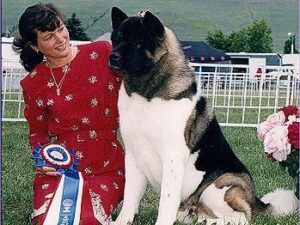
Ingrid Linerud-Strom is breeder behind Crown Royal Akitas. Read about the kennel’s beginnings, the puppies, and much more!
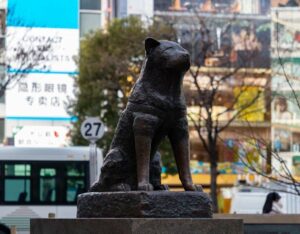
Discover the touching story of Hachiko, an exceptional dog whose unwavering love and loyalty captured the hearts of millions around the world.
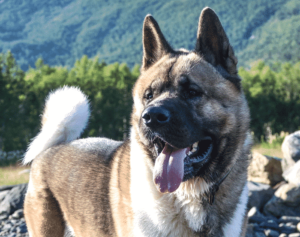
If it were necessary to describe the Akita in one word, dignity would suffice for it is this concept that the breed embodies.
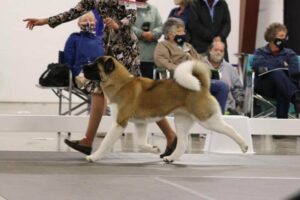
Shawn & DeeLynn Piccone are the breeders behind Chelsea’s Akitas. Read about the kennel’s beginnings, champion dogs, puppies, photos & more!
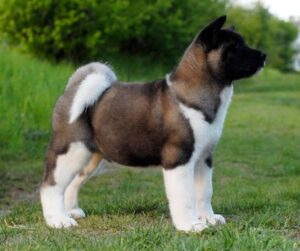
Cory Crayton is the breeder behind Titan Akitas. Read about the kennel’s beginnings, champion dogs, Akita puppies, photos and more!
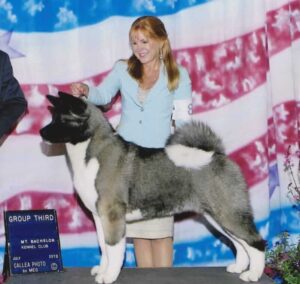
This is my routine when judging the Akita. If there are multiple entries in a class, I bring them in and line them up, looking for balance
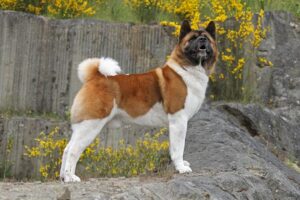
The Heart of the Breed | First Akita in the United States was gifted to Helen Keller in 1937 after she visited Japan’s Akita region.

"*" indicates required fields
Showsight Magazine–the world’s most influential purebred dog publication since 1992. Each issue reaches a global audience dedicated to preserving the history and health of purpose bred dogs. Filled with award-winning editorial focused on news and insights from the dog show community, top breeders, handlers, AKC Judges, and more!